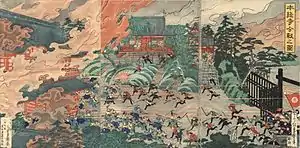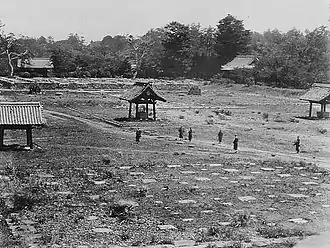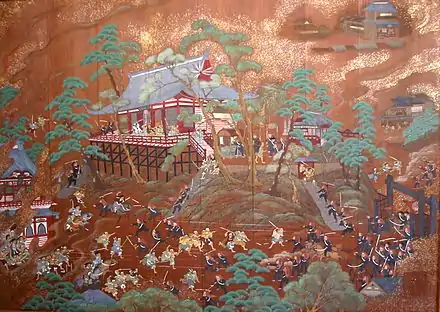Battle of Ueno
The Battle of Ueno (上野戦争, Ueno Sensō) was a battle of the Boshin War, which occurred on July 4, 1868 (Meiji 1, 15th day of the 5th month),[1] between the troops of the Shōgitai under Shibusawa Seiichirō and Amano Hachirō, and Imperial "Kangun" troops.
| Battle of Ueno 上野戦争 | |||||||
|---|---|---|---|---|---|---|---|
| Part of Boshin War | |||||||
 Battle of Ueno.  The attack on Kan'ei-ji Temple, labeled here as "The attack of Honnō-ji" (本能寺) in the Battle of Ueno. The Shogitai (彰義隊) troops are on the left, in samurai garb, and Imperial troops with modern uniforms are on the right (the "Red bear" (赤熊, Shaguma) wigs indicate soldiers from Tosa Jinshotai(迅衝隊)). | |||||||
| |||||||
| Belligerents | |||||||
| Satsuma, Chōshū, Tosa, Saga, Jinshotai | Former Bakufu troops, Shōgitai | ||||||
| Commanders and leaders | |||||||
|
Ruler: Emperor Meiji Army: Ōmura Masujirō Satsuma: Saigō Takamori, Tosa: Itagaki Taisuke |
Shibusawa Seiichirō Amano Hachirō | ||||||
| Strength | |||||||
|
2,000 Imperial troops 10,000 reinforcements | 2,000 Bakufu troop, 1,000 (during the first battle) | ||||||
| Casualties and losses | |||||||
| 100 |
300 266 (during the first battle) | ||||||
Prelude
Though the Shōgitai was mostly made up of former Tokugawa retainers and residents of the surrounding provinces, some domains supported the Shōgitai, such as Takada han (Echigo Province, 150,000 koku), Obama han (Wakasa Province, 103,000 koku), Takasaki han (Kōzuke Province, 52,000 koku), and Yūki han (Shimosa Province, 18,000 koku).[2]
Facing them were the combined forces of the Chōshū, Ōmura, Sadowara, Hizen, Chikugo, Owari, Bizen, Tsu, Inaba, and Higo domains, under the general command of Chōshū's Ōmura Masujirō.[3]
Shibusawa and Amano initially had the 2000-strong Shōgitai posted in Ueno to protect Tokugawa Yoshinobu, who was, at the time, in self-imposed confinement at Ueno's Kan'ei-ji Temple, as well as Prince Rinnōji no Miya Yoshihisa, who was the abbot of the temple,[4] and was to become the new dynastic leader of the Tokugawa resistance as "Emperor Tōbu".
From their base, the Shogitai had been harassing Imperial troops, creating trouble in Edo, thus forcing the Imperial side, although outnumbered, to take action.[5]
Battle

The Shōgitai took up positions around Kan'ei-ji (寛永寺; an important Tokugawa family temple) and the nearby Nezu Shrine (根津神社).[6] When the battle began, the forces of Satsuma, led by Saigō Takamori, attacked head-on at the gate, but were stopped by the Shogitai forces, which were superior in number. The Satsuma forces suffered heavy casualties, until the forces of Choshu managed to make a second attack from the rear, which unblocked the tactical stalemate.[5] While the Shogitai put up stiff resistance, the Tosa troops also used Armstrong cannons and Snider guns to devastating effect, thus ending the last center of resistance in Edo. According to Saigō Takamori:
"With our ample preparations we made short work of [the enemy], and this is an exceptional and extreme delight."
— Saigō Takamori[5]

Rinnōji no Miya escaped, reached Enomoto Takeaki's warship Chogei-maru and was dropped off further north, on the Pacific coast.[6] Harada Sanosuke of the Shinsengumi is said to have joined the Shōgitai, and died soon after this battle.[7] About 300 Shogitai are said to have died in the battle, and a thousand houses were burnt in collateral damages.


Notes
- NengoCalc: 明治一年五月十五日; n.b., the old lunar calendar date is sometimes misidentified as "May 15th."
- Mori Mayumi. Shōgitai Ibun. Tōkyō: Shinkōsha, 2004, p. 123.
- Mori Mayumi. Shōgitai Ibun. Tōkyō: Shinkōsha, 2004, p. 170.
- Gekidosuru Aizu Boshin Hen. Vol. 5 of Aizuwakamatsu Shi. Tōkyō: Kokushō-kankōkai, 1981, p. 138
- The last samurai Mark Ravina p.157
- Yamakawa Kenjirō. Aizu Boshin Senshi Tōkyō: Tōkyō Daigaku Shuppankai, 1931, p. 196.
- Kikuchi Akira. Shinsengumi Hyakuichi no Nazo. Tokyo: Shin Jinbutsu Oraisha, 2000, pp. 228–229.
Further reading
- Kikuchi Akira. Shinsengumi Hyakuichi no Nazo. Tōkyō: Shin Jinbutsu Ōraisha, 2000.
- Mori Mayumi. Shōgitai Ibun. Tōkyō: Shinkōsha, 2004.
- Steele, M. William. Against the Restoration. Katsu Kaishu's Attempt to Reinstate the Tokugawa Family. Monumenta Nipponica, Vol. 36, No. 3. (Autumn, 1981), pp. 299–316.
- Steele, M. William. Edo in 1868: The View from Below. Monumenta Nipponica, Vol. 45, No. 2. (Summer, 1990), pp. 127–155.
- Takano Kiyoshi. Tokugawa Yoshinobu: Gendai Nihon no Enshutsusha. Tōkyō: Nihon Hōsō Shuppan Kyōkai, 1997.
- Yamakawa Kenjiro. Aizu Boshin Senshi. Tokyo: Tokyo Daigaku Shuppankai, 1931.